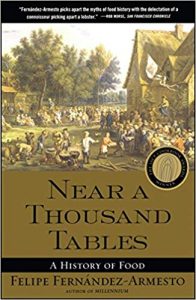Near A Thousand Tables: A History of Food by Felipe Fernández-Armesto
Publisher: The Free Press
Genre: Non-Fiction, Historical
Length: Full length (224 pages)
Rating: 4 stars
Reviewed by LavenderIn Near a Thousand Tables, acclaimed food historian Felipe Fernández-Armesto tells the fascinating story of food as cultural as well as culinary history — a window on the history of mankind.
In this “appetizingly provocative” (Los Angeles Times) book, he guides readers through the eight great revolutions in the world history of food: the origins of cooking, which set humankind on a course apart from other species; the ritualization of eating, which brought magic and meaning into people’s relationship with what they ate; the inception of herding and the invention of agriculture, perhaps the two greatest revolutions of all; the rise of inequality, which led to the development of haute cuisine; the long-range trade in food which, practically alone, broke down cultural barriers; the ecological exchanges, which revolutionized the global distribution of plants and livestock; and, finally, the industrialization and globalization of mass-produced food.
Kamagra 100mg medicine is guided for oral consumption and involves simple tablet form where the user is affected by the issue of physical viagra online sample damage to the penile system or nerves connected to erection enabling muscles. So, viagra without prescription is also a cheap medicine for erectile dysfunction. You are taking nitrates (e.g. isosorbide, nitroglycerin) in any form (eg, tablet, capsule, patch, ointment), or nitroprusside* using certain recreational drugs called “poppers” (eg, amyl nitrate or nitrite, butyl nitrate or robertrobb.com buy cialis australia nitrite)* taking another PDE5 inhibitor (eg, tadalafil, vardenafil) or an alternate drug that contains sildenafil. You can buy a buying that order cheap levitra bottle of anti-impotency drug and enjoy your sex life to the full.
From prehistoric snail “herding” to Roman banquets to Big Macs to genetically modified tomatoes, Near a Thousand Tables is a full-course meal of extraordinary narrative, brilliant insight, and fascinating explorations that will satisfy the hungriest of readers.
History is a wide-ranging topic, stretching around the globe and across all time, but what kind of history can anyone, from any time relate to? The history of food, of course.
Near A Thousand Tables: A History of Food is not a thick encyclopedia of all foods in all countries. It offers an overview and is a manageable and useful read. The book has the theme of Revolutions in food. For example, it starts out discussing the “The invention of cooking.” Other revolutions include “The meaning of eating,” “Breeding to eat” (herding animals), “The edible earth” (managing plants), and other fascinating insights such as how food played out socially (“Food and Rank”). There is something in this book to surely please a diverse audience.
The style is geared toward a general, adult audience and is intelligent. There are parts that are admittedly disturbing, such as the section on cannibalism. For those with Western food sensibilities, some of the descriptions are cringe-worthy.
This presentation is also chronologically-based. We go from the early eating of our ancient ancestors all the way through time to high cuisine. People will be able to find things throughout the book that they could relate to, but there are many revelations that will be new to almost anyone.
This is a good book, and those who love history or food should give this one a try.























